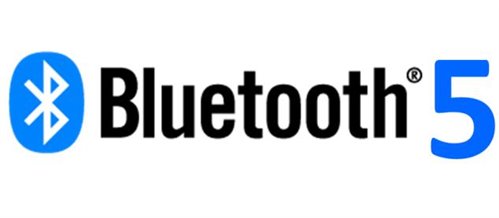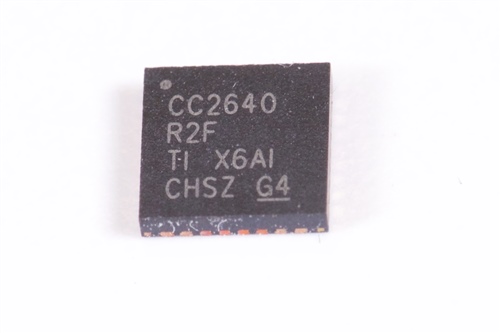SSZTAG2 january 2017 CC2640 , CC2640R2F
With the core specification version 5.0, Bluetooth® is no longer a wireless protocol just for personal area networks (PAN). Three new data rates have been added to the spec, two of which are specifically tailored to increase the range of Bluetooth low energy connections. This will facilitate networks with good indoor and outdoor coverage, well suited for Internet of Things (IoT) products for home, building and industrial automation.

But what is the actual range of a Bluetooth 5 radio link? In this video, we demonstrate an impressive 1.6 km outdoor range between two SimpleLink™ Bluetooth low energy CC2640R2F wireless microcontroller (MCU) LaunchPad™ development kits using the new 125 kbps Coded PHY (PHYsical) format. So why don’t we specify 1.6 km range in the CC2640R2F wireless MCU datasheet?

Tiny chip goes a long way: The CC2640R2F wireless MCU comes in several package options including a 2.7mm x 2.7mm chip-scale package (WCSP)
Unfortunately, it’s not that simple. As system developers and RF designers, we can specify parameters that impact the range and we can measure them in controlled environments with reliable and repeatable results. But the “end result,” the range, will vary significantly once you take your RF devices out in the real world, where multiple reflections, obstructions and interfering RF activity all add up to two random variables that will decide whether or not you can establish a link between the two locations you have chosen for your devices. The first variable is the transmission path loss, which is a measure of how much of the transmitted power that is picked up by the receiver. The second variable is the actual sensitivity level at the receiver’s location. The latter is determined by the amount of interfering RF power seen by the receiver. If no interference is present, the sensitivity level is determined by the thermal background noise and will correspond to the sensitivity specified in the datasheet.
A common term used to describe the range capability of an RF system is link budget. Link budget is a comparison (or ratio) between transmit power and sensitivity level. In an operating RF link, the transmitter will transmit at a specified RF power level, and a (usually very tiny) fraction of that RF power will be picked up by the receiving antenna and fed to the receiver. If that fraction is too small, the received power level will drop below the receiver sensitivity level and the link will fail. The link budget is therefore defined as the ratio between the transmitted power and the receiver sensitivity level, or

For convenience, link budget is usually denoted in a logarithmic scale (dB). Output power and sensitivity are usually denoted in a logarithmic scale relative to 1mW (dBm). This means that

It immediately becomes clear that there are two ways in which you can improve your link budget. You can either:
- Increase the output power
- Improve (reduce) the receiver sensitivity level
Increasing the output power is fairly straight forward, but it comes at the cost of (sometimes significantly) increased power consumption and eventually problems with regulatory compliance. All regulatory jurisdictions have limits on RF emission levels and unwanted spurious emissions, both of which will increase when we increase the transmit power.
The other option, improving receiver sensitivity, is the path chosen by the Bluetooth SIG when Bluetooth 5 was adopted with the intention of offering four times the RF range. We also chose this option to provide the longest range Bluetooth low energy solutions at lowest power consumption. Notice that no actual range is specified by Bluetooth SIG or any of the hardware manufacturers (including us). What we specify is only a theoretical ratio based on a tangible and measurable improvement in the sensitivity level. If we were able to measure the range in a completely controlled environment, we would see this exact improvement in practice. But a controlled environment is either an anechoic antenna chamber or outer space (with no other radiation sources). Unfortunately, neither km-long antenna chambers nor outer space are economically viable to test ranges.
In free space, a doubling of the range requires a quadrupling of the link budget (or 6dB increase). This means that four times the range requires 12dB better sensitivity for the new Bluetooth 5 long range data rate, known as “Coded PHY,” when compared with the original 1-Megabit/s Bluetooth 4.0 LE receivers that have been around since 2010.
At the time when the new Coded PHYs were being defined and discussed by the Bluetooth SIG, the best Bluetooth low energy receivers had a sensitivity level of around -93dBm. This was used as the reference level to which the new Coded PHYs would be compared, and so the new modulation and coding format would need to accommodate a realistic sensitivity level of -105dBm. This is exactly what the new 125kbps Coded PHY does, and it does it through a two-way approach. The biggest improvement comes simply from the fact that the data rate is reduced to 1/8th , which means that every bit carries eight times more energy for any given power level. Theoretically, this allows the receiver to receive signals at 9dB lower power levels and still accumulates the same energy per bit as before.
We’re still 3 dB short of the 12 dB we were looking for. The last 3 dB can be achieved due to the coding employed. The -93dBm comparison level (for 1Mpbs) assumed a standard differential demodulator, where each received symbol (1 symbol per bit) is determined to be “1” or “0” based on a comparison with the previous symbol. The Coded PHYs facilitate a semi-coherent receiver where eight symbols make up 1 bit, and correlators can search for these known symbol sequences.
The CC2640R2F wireless MCU today delivers the industry’s best sensitivity level of -103dBm, which is only 2dB short of the -105dBm target. With the +5dBm output power available from CC2640R2F device, this provides an impressive 108dB link budget. We are continuing the expansion of the SimpleLink CC264x device family with more memory and security, and with these devices we are also targeting getting even closer to the 12 dB goal set by Bluetooth SIG in 2017.
So this is the story of the 12-dB sensitivity improvement in Bluetooth 5, and how it theoretically gives four times improvement in range compared with the first Bluetooth low energy receivers without increasing the output power. In the meantime, the new CC2640R2F wireless MCU has improved the 1Mbps sensitivity level from -93dBm to -97dBm by employing various techniques to get a little bit closer to the performance of a coherent receiver.
We have conducted an outdoor range test with our new SimpleLink CC2640R2F wireless MCU using the 125kbps PHY in a highly uncontrolled environment near our office in Oslo, Norway, where we were able to retain a connection over a 1.6km range.
Although actual range will vary depending on the environment and application as explained earlier, the key take-away from this experiment is that Bluetooth 5 is certain to enhance range significantly over Bluetooth 4.x and this opens up the possibilities for exciting new applications.
Finally, it should be mentioned that power consumption is still a key care about for most Bluetooth low energy applications. The range demonstration we showed in the video used a transmit power level of only +5dBm, which consumes around 9mA peak power in TX and 6mA in RX. Coupled with the very low standby current consumption of the CC2640R2F device, this allows great indoor and outdoor coverage for Bluetooth low energy applications that can enjoy years of operation on a coin cell battery.
Now our challenge goes out to you – how will you leverage Bluetooth 5 long range mode? Alarm sensors? Smoke detectors? Lighting control? Share with us in the comments. The innovation is endless with a Bluetooth low energy connection that is powered by a small coin cell battery and can carry data to and from all corners of your house, building or factory.
Software development kits (SDKs) supporting the new Bluetooth low energy standard for SimpleLink CC2640R2F wireless MCU are expected to be released in Q2 and Q3 2017. Note that the SimpleLink CC2640R2F wireless MCU has been in mass production since early December 2016.
To Start Developing Your Bluetooth Low Energy Application Today:
- Visit TI’s SimpleLink Bluetooth low energy CC2640R2F wireless MCU product folder
- Order a Bluetooth low energy LaunchPad kit to quickly kick start development.
- Have additional questions? Ask our engineer experts on the TI E2E™ online community Bluetooth low energy forum.
- Want to learn about Bluetooth low energy? Read our other blog posts:
- 5 need to know facts about the new SimpleLink™ Bluetooth low energy CC2640R2F wireless MCU
- High performance and low power…The original dynamic duo
- Make your Bluetooth® low energy solution fast, simple and secure with new Bluetooth 4.2 certified software
- How Bluetooth® 4.2 can help enable product security
- Bluetooth® 5 will unlock the power of the SimpleLink™ CC2640 wireless MCU
- How Bluetooth® low energy technology revolutionizes healthcare